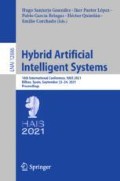Abstract
Morphological development has shown its efficiency in improving learning and adaptation to the environment in natural organisms from infancy to adulthood. In the case of robot learning, this is not so clear. The results of a series of experiments that have been carried out in previous work have allowed us to extract, from an analytical perspective, some notions about how and under what conditions morphological development may influence learning. In this paper, we want to adopt an engineering or synthesis perspective and test whether these notions can be used to construct a successful morphological development strategy for a difficult task: learning bipedal locomotion. In particular, we have addressed learning to walk in a 14 degrees of freedom NAO type robot and have designed a morphological development strategy to this end. The results obtained have allowed us to validate the relevance of the assumptions made for the design and implementation of a morphological development strategy.
Access this chapter
Tax calculation will be finalised at checkout
Purchases are for personal use only
References
Piaget, J., Cook, M.: The Origins of Intelligence in Children. International Universities Press, New York (1952)
Thelen, E.: Motor development as foundation and future of developmental psychology. Int. J. Behav. Dev. 24, 385–397 (2000). https://doi.org/10.1080/016502500750037937
Kriegman, S., Cheney, N., Bongard, J.: How morphological development can guide evolution. Sci. Rep. 8, 1–17 (2018). https://doi.org/10.1038/s41598-018-31868-7
Baranes, A., Oudeyer, P.-Y.: The interaction of maturational constraints and intrinsic motivations in active motor development. In: IEEE International Conference on Development and Learning (ICDL), pp. 1–8 (2011)
Bongard, J.: The utility of evolving simulated robot morphology increases with task complexity for object manipulation. Artif. Life. 16, 201–223 (2010). https://doi.org/10.1162/artl.2010.Bongard.024
Vujovic, V., Rosendo, A., Brodbeck, L., Iida, F.: Evolutionary developmental robotics: improving morphology and control of physical robots. Artif. Life. 23, 169–185 (2017)
Savastano, P., Nolfi, S.: A robotic model of reaching and grasping development. IEEE Trans. Auton. Ment. Dev. 5, 326–336 (2013)
Ivanchenko, V., Jacobs, R.A.: A developmental approach aids motor learning. Neural Comput. 15, 2051–2065 (2003). https://doi.org/10.1162/089976603322297287
Bongard, J.: Morphological change in machines accelerates the evolution of robust behavior. Proc. Natl. Acad. Sci. 108, 1234–1239 (2011). https://doi.org/10.1073/pnas.1015390108
Buckingham, D., Bongard, J.: Physical scaffolding accelerates the evolution of robot behavior. Artif. Life. 23, 351–373 (2017)
Naya-Varela, M., Faina, A., Duro, R.J.: An experiment in morphological development for learning ANN based controllers. In: IEEE World Congress on Computational Intelligence (WCCI). Glasgow (UK) (2020)
Naya-Varela, M., Faina, A., Duro, R.J.: Some experiments on the influence of problem hardness in morphological development based learning of neural controllers. In: de la Cal, E.A., Villar Flecha, J.R., Quintián, H., Corchado, E. (eds.) HAIS 2020. LNCS (LNAI), vol. 12344, pp. 362–373. Springer, Cham (2020). https://doi.org/10.1007/978-3-030-61705-9_30
Naya-Varela, M.: Study of morphological development as a tool for learning robotic controllers (2021). http://hdl.handle.net/2183/27718
Chestnutt, J., Lau, M., Cheung, G., Kuffner, J., Hodgins, J., Kanade, T.: Footstep planning for the Honda Asimo humanoid. In: Proceedings of the 2005 IEEE International Conference on Robotics and Automation, pp. 629–634 (2005)
Hartley, R., et al.: Legged robot state-estimation through combined forward kinematic and preintegrated contact factors. In: 2018 IEEE International Conference on Robotics and Automation (ICRA), pp. 1–8 (2018)
Feng, S., Xinjilefu, X., Atkeson, C.G., Kim, J.: Optimization based controller design and implementation for the atlas robot in the darpa robotics challenge finals. In: 2015 IEEE-RAS 15th International Conference on Humanoid Robots (Humanoids), pp. 1028–1035 (2015)
Lungarella, M., Berthouze, L.: On the interplay between morphological, neural, and environmental dynamics: a robotic case study. Adapt. Behav. 10, 223–241 (2002). https://doi.org/10.1177/1059712302919993005
Berthouze, L., Lungarella, M.: Motor skill acquisition under environmental perturbations: on the necessity of alternate freezing and freeing of degrees of freedom. Adapt. Behav. 12, 47–64 (2004). https://doi.org/10.1177/105971230401200104
Hardman, D., George Thuruthel, T., Iida, F.: Towards growing robots: a piecewise morphology-controller co-adaptation strategy for legged locomotion. In: Mohammad, A., Dong, X., Russo, M. (eds.) TAROS 2020. LNCS (LNAI), vol. 12228, pp. 357–368. Springer, Cham (2020). https://doi.org/10.1007/978-3-030-63486-5_37
Zhu, J., Rong, C., Iida, F., Rosendo, A.: Scaffolded Learning of Bipedal Walkers: Bootstrapping Ontogenetic Development. bioRxiv. (2020). https://doi.org/10.1101/2020.10.03.324632
Ha, D.: Reinforcement learning for improving agent design. Artif. Life. 25, 352–365 (2019). https://doi.org/10.1162/artl_a_00301
Pratt, J., Dilworth, P., Pratt, G.: Virtual model control of a bipedal walking robot. In: Proceedings of International Conference on Robotics and Automation, pp. 193–198 (1997)
Robotics, C.: CoppeliaSim. https://www.coppeliarobotics.com/
James, S., Freese, M., Davison, A.J.: Pyrep: Bringing v-rep to deep robot learning. arXiv Prepr. arXiv1906.11176 (2019)
Stanley, K.O., Miikkulainen, R.: Evolving neural networks through augmenting topologies. Evol. Comput. 10, 99–127 (2002)
Chervenski, P., Ryan, S.: MultiNEAT, project website (2012). http://www.multineat.com/
Smith, R.L.: Open Dynamics Engine. https://www.ode.org/
CESGA: CESGA. Centro de Supecomputacion de Galicia. http://www.cesga.es/
Abdi, H.: Holm’s sequential Bonferroni procedure. Encycl. Res. Des. 1, 1–8 (2010)
Ahmad, H., Nakata, Y., Nakamura, Y., Ishiguro, H.: PedestriANS: a bipedal robot with adaptive morphology. Adapt. Behav. 1059712320905177 (2020). https://doi.org/10.1177/1059712320905177
Acknowledgment
This work has been partially funded by the Ministerio de Ciencia, Innovación y Universidades of Spain/FEDER (grant RTI2018–101114-B-I00) and Xunta de Galicia (grant EDC431C-2021/39). We wish to acknowledge the support received from the Centro de Investigación de Galicia “CITIC”, funded by Xunta de Galicia and the European Union (European Regional Development Fund-Galicia 2014–2020 Program), by grant ED431G 2019/01. We also want to thank CESGA (Galician Supercomputing Center) for the use of their resources.
Author information
Authors and Affiliations
Corresponding authors
Editor information
Editors and Affiliations
Rights and permissions
Copyright information
© 2021 Springer Nature Switzerland AG
About this paper
Cite this paper
Naya-Varela, M., Faina, A., Duro, R.J. (2021). Learning Bipedal Walking Through Morphological Development. In: Sanjurjo González, H., Pastor López, I., García Bringas, P., Quintián, H., Corchado, E. (eds) Hybrid Artificial Intelligent Systems. HAIS 2021. Lecture Notes in Computer Science(), vol 12886. Springer, Cham. https://doi.org/10.1007/978-3-030-86271-8_16
Download citation
DOI: https://doi.org/10.1007/978-3-030-86271-8_16
Published:
Publisher Name: Springer, Cham
Print ISBN: 978-3-030-86270-1
Online ISBN: 978-3-030-86271-8
eBook Packages: Computer ScienceComputer Science (R0)

